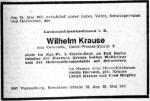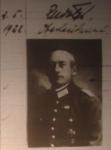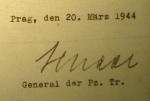-
Posts
4,908 -
Joined
-
Last visited
-
Days Won
97
Content Type
Profiles
Forums
Blogs
Gallery
Events
Store
Everything posted by Dave Danner
-
I guess I can add a couple of small details after all... It's Rudolph, not Rudolf. Oskar Bruno Rudolph, born 5.9.1885 in Passenheim, Kreis Ortelsburg, East Prussia. He was the son of Julius Rudolph, a Gendarmeriewachtmeister a.D. in Neustettin, who died on 18.8.1930, and Auguste née Schulz, who died on 12.11.1906. Oskar was married on 12.12.1918 in Neustettin to Agnes Sommer, born 4.4.1890, daughter of Reinhold Sommer, a Kaufmann in Neustettin. Oskar entered the army on 118.10.1903 as a Freiwilliger in a Fußartillerie Regiment (the number isn't legible, but it looks like FußAR 13). He was promoted to Obergefreiter on 18.9.04 and Unteroffizier on 19.9.05. He was promoted to Feuerwerker on 1.1.09 and transferred to the Artillerie-Depot Danzig. He then served in various Artillerie-Depots, and was promoted to Oberfeuerwerker on 1.10.12 and Feuerwerks-Leutnant on 30.5.14. After mobilization, he was assigned to the staff of several Fußartillerie-Regiments and to the Generalkommando XVIII.Armeekorps. After the war, on entering the Reichsheer, he was assigned to the Depot-Inspektion of the Feldzeugmesiterei. He was characterized an Oberleutnant on 17.8.20 and transferred to the Zeugamt Königsberg. He was discharged on 15.4.21 due the reductions in the German armed forces, but came back a short while later on 15.6.21. He was promoted to Oberleutnant beim Zeugamt on 28.9.21, with effect from 1.7.21, and was later given an RDA of 25.2.15 (2). He was promoted to Hauptmann beim Zeugamt on 1.2.28 (I'm not sure about the RDA, but it looks like 18.4.17 (31)). He went to the Munitions-Institut Ingolstadt in 1930. He was promoted to Major (W) on 1.10.33 with an RDA of 1.8.30 (3) and was named Vorstand of the Zeugamt Ingolstadt on 23.12.33 with effect from 1.2.34. On 20.4.35, he became an Oberstleutnant (W) with effect from 1.4.35 and an RDA of 1.4.34 (33). In 1936 he went to the Heeres-Feldzeugmeisterei V. He was promoted to Oberst (W) on 31.12.38 with effect from 1.1.39. On 16.2.39, with effect from 1.3.39, he became leader, then commander of Feldzeugstab (Fest) F beim Generalkommando der Grenztruppen Oberrhein. From 4.10.40 to 28.9.41, he was leader of the Feldzeugarbeitsstab Elsaß in Straßburg. On 29.9.41, he went to Feldzeuggruppe 1. I don't know why he disappeared from the ranklist, but he was with Feldzeuggruppe 1 until 6.2.44. There is a hard-to-read entry that seems to say he may have been retired from active duty but remained in the position; however, his March 1944 evaluation report lists him as an active officer. On 7.2.44 he was transferred to the Feldzeuginspizient des Ersatzheeres. On 12.11.44 he was transferred to the staff of the Stellv. Generalkommando X.Armeekorps and tasked as Feldzeug commander (m.d.W.d.G. des Feldzeugkommandeurs beauftragt). That is the last entry in his personnel file. Decorations: EK2 (28.3.15) ÖM3K (2.8.15) EK1 (13.3.16) VAs (4.8.18) HT (19.8.18) The Wehrmacht/Heer long service (WHDA) and the Honor Cross for Combatants (FKE) aren't listed in his file, but presumably as an active officer at the time he got the FKE in December 1934 and the WHDA1 on 2.10.36. His World War Two decorations were: Schutzwall-Ehrenzeichen (15.3.40, Nr. 15188) KVK2X (20.11.40) KVK1X (17.2.44) Here is his file photo:
-
Erwin Jaenecke 22.4.1890-3.7.1960 Generalmajor - 1.11.39 Generalleutnant - 1.11.41 General der Pioniere - 1.11.42 Generaloberst - 30.1.44 Bio: http://de.wikipedia..../Erwin_Jaenecke BIo: http://www.lexikon-d...J/JaeneckeE.htm Bio: http://www.geocities...ECKE_ERWIN.html Signature from his personnel file:
-
Erwin Ludwig von Steinberg, born in Oberkirch, Baden, on 17 May 1867. Married 4 October 1894 to Luise Agnes Gustava Elsbeth (Else) Freiin von Berg. After leaving active duty, they lived in Eschenhof bei Winterbach, Baden. They had one son, Heinz Martin Alexander Erwin Bernhard, born 4 April 1909 in Eschenhof. 16.05.1888 - Portepée-Fähnrich, 1.GFAR 15.01.1889 - Sek.-Lieut., 1.GFAR 15.02.1890 - transferred to Reserve of 1.GFAR, commanded to FAR 15 19.05.1891 - returned to active duty with FAR 15, with Patent of 15.02.1889 18.08.1896 - Prem.-Lieut., transferred to FAR 10 01.04.1899 - commanded to the Great General Staff for one year 01.04.1900 - transferred to FAR 46 01.10.1900 - promoted to Hauptmann (no Patent) 01.04.1903 - transferred to FAR 14 as a Batterie-Chef 27.01.1904 - Patent as Hauptmann (P3p) 17.11.1906 - Retired 14.11.1916 - char. Major Besides the BZ3bXE Christoph noted above, he also had a peacetime RAO4, Centenary, and BZ3bXE. With wartime service, he probably would have qualified for the DA25 by 1918. Regards, Dave
-
Walter Chales de Beaulieu 14.6.1898-26.8.1974 Generalmajor (1.6.43) Generalleutnant (20.6.44) Ia, XVI. Armeekorps Chef d. Generalstabes d. XVI. Armeekorps Chef d. Generalstabes d. Panzergruppe 4 Chef d. Generalstabes d. 4. Panzerarmee Kdr. Pz.Gren.Rgt. 394 Kdr. 26. Pz.Gren.Brig. Fhr., then Kdr. 168. Inf.Div. Kdr. 23. Inf.Div. Bio: http://www.reocities.com/~orion47/WEHRMACHT/HEER/Generalleutnant/CHALES_WALTER.html Signature on an evalation report for Oberstlt. Paul Spoida, Kdr. Gren.Rgt. 417
-
Felmy, Hellmuth 28.5.1885-14.12.1965 General der Flieger Oberbefehlshaber der Luftflotte 2 Chef Sonderstab F (Deutsche Militärmission nach dem Irak) Militärbefehlshaber Südgriechenland Komm. Gen. Generalkommando.z.B.V. Felmy Komm. Gen. LXVIII. Armeekorps Komm. Gen. XXXIV. Armeekorps Deutsches Kreuz in Gold (DKiG) - 16.1.1945 Bio: https://www.lexikon-der-wehrmacht.de/Personenregister/F/FelmyHellmuth.htm Bio: http://www.geocities...Y_HELLMUTH.html Bio: http://de.wikipedia..../Hellmuth_Felmy Evaluation report for Maj. Walter von Gal, Adj. LXVIII.A.K.
-
General der Panzertruppe Friedrich Paulus Born: 23.9.1890 Died: 1.1.1957 Generalfeldmarschall Chef d. Generalstabes d. 10. Armee Chef d. Generalstabes d. 6. Armee Oberquartiermeister I, Generalstab des Heeres Oberbefehlshaber 6. Armee Bio: http://www.lexikon-d...er/P/Paulus.htm Bio: http://www.reocities.com/orion47.geo/WEHRMACHT/HEER/Generalfeldmarschall/PAULUS_FRIEDRICH.html Evaluation report for Gen.Lt. (later Gen.d.Art.) Max Pfeffer
-
Rundstedt, Karl Rudolf Gerd von 12.12.1875-24.2.1953 Generalfeldmarschall Oberbefehlshaber Heeresgruppe Süd, September-October 1939 Oberbefehlshaber Ost, October 1939 Oberbefehlshaber Heeresgruppe A, October 1939-October 1940 Oberbefehlshaber West, October 1940-June 1941 Oberbefehlshaber Heeresgruppe Süd, June 1941-December 1941 Oberbefehlshaber West, March 1942-July 1944, September 1944-March 1945 Bio: http://www.lexikon-d...RundstedtGv.htm Bio: http://www.reocities.com/orion47.geo/WEHRMACHT/HEER/Generalfeldmarschall/RUNDSTEDT_GERD.html Endorsement to evaluation report on Gen.d.Art. Kurt Gallenkamp:
-
Ferdinand Schaal 7.2.1889-9.10.1962 General der Panzertruppe Kdr. 10.Pz.-Div. Fhr. XXXIV. Armeekorps Komm. Gen. LVI.Panzerkorps Befehlshaber in Wehrkreis Böhmen u. Mähren & Bevollmächtigter b. Reichsprotektor in Böhmen und Mähren Ritterkreuz des Eisernen Kreuzes (RK) - 13. Juli 1941 Deutsches Kreuz in Gold (DKiG) - 8. März 1942 Bio: http://www.lexikon-d...alFerdinand.htm Bio: http://www.reocities.com/~orion47/WEHRMACHT/HEER/General2/SCHAAL_FERDINAND.html Signature on an officer evaluation report:
-
Wickede, Thomas-Emil von 23.04.1893-23.06.1944 General der Infanterie Kdr. II./Inf.-Regt. 4 Kdr. Inf.-Regt. 4 Kdr. Inf.-Regt. 409 Kdr. 30. Inf.-Div. Fhr. X. Armeekorps Komm. Gen. X. Armeekorps Bio: http://www.lexikon-d...ThomasEmilv.htm Bio: http://www.geocities...CKEDE_EMIL.html
-
-
An old thread, but I have some additional information on Hptm. von der Groeben. Friedrich Otto Albrecht von der Groeben was born on 27. September 1870. He was promoted Major on 28.11.14 (Pp) and commanded Res.-Jäg.-Btl. 7. Other known wartime decorations: Preußen: Eisernes Kreuz 2. Klasse - 15.9.14 Preußen: Eisernes Kreuz 1. Klasse - 7.10.14 Bayern: Militärverdienstorden mit der Krone und mit Schwertern - 21.12.17 Schaumburg-Lippe: Kreuz für treue Dienste - 12.11.14 Lippe: Kriegsverdienstkreuz - 26.3.16
-
The order in the lower picture on the white background looks like a Grand Cross set, so it should be pricier. It is also a rather rare decoration - the Hungarian Order of Merit was the more common award during the war, even for Germans. The "Dekoration" is the wreath around the cross. It is the "war decoration", used to distinguish wartime awards from peacetime ones.
-
Some additional bits of information: 30.01.09 - Left command of III.See-Btl. and attached to III.Stamm-See-Btl. 04.08.09 - Released from navy service and assigned to the staff of IR 32, I believe with effect from 1. Sept. 1909 02.09.09 - Award of Prussian Crown Order III. Class gazetted in the Militär-Wochenblatt 17.09.09 - Named a battalion commander in IR 32 16.11.10 - Transferred to the staff of IR 28 20.04.11 - Award of the Commander's Cross II. Class of the Saxe-Ernestine House Order (Komturkreuz II. Klasse des Herzoglich Sachsen-Ernestinischen Haus-Ordens) gazetted in the Militär-Wochenblatt 17.01.12 - Retired 15.01.16 - Award of the Bavarian Military Merit Order III. Class with Crown and Swords (Militär-Verdienstorden III. Kl. mit der Krone und mit Schwertern) 21.11.16 - Award of Prussian Crown Order II. Class with Swords gazetted in the Militär-Wochenblatt He also received the Officer's Cross of the Netherlands House Order of Oranje at some point. It is listed in the 1910 rank list, but not 1909. I don't see an entry in the Militär-Wochenblatt, so he might have been awarded it before leaving navy service.













